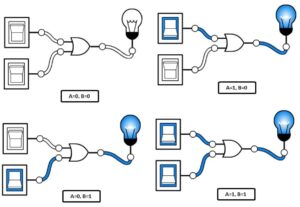Introduction
In the world of modern electronics, Complementary Metal-Oxide-Semiconductor (CMOS) technology plays a pivotal role.
From its humble beginnings to its current dominance, CMOS has come a long way.
In this blog post, we will delve into the history of its technology, tracing its evolution from invention to becoming the backbone of today’s LSI and VLSI devices.
The Birth of Complementary Symmetry
The concept of complementary symmetry was first introduced by George Sziklai in 1953. Sziklai went on to discuss several complementary bipolar circuits.
At RCA, Paul Weimer made a significant contribution in 1962 by inventing thin-film transistor (TFT) complementary circuits, which are closely related to CMOS technology. Weimer developed complementary flip-flop and inverter circuits, although he did not delve into more complex complementary logic.
Notably, he became the first person to successfully integrate both p-channel and n-channel TFTs on the same substrate.
Three years before Weimer’s work, John T. Wallmark and Sanford M. Marcus published a series of integrated circuits implementing various complex logic functions using JFETs, including complementary memory circuits.
Frank Wanlass, who played a role in the development of CMOS technology, was also aware of Weimer’s contributions at RCA.
The MOSFET Invention
The MOSFET (Metal-Oxide-Semiconductor Field-Effect Transistor), also known as the MOS transistor, was invented by Mohamed M. Atalla and Dawon Kahng at Bell Labs in 1959.
At the time, there were two original MOSFET fabrication processes: PMOS (p-type MOS) and NMOS (n-type MOS). Atalla and Kahng developed both of these processes when they initially created the MOSFET, producing PMOS and NMOS devices with gate lengths of 20 µm and later 10 µm in 1960.
Interestingly, the MOSFET was initially somewhat overlooked and not given much attention at Bell Labs, as bipolar transistors were the preferred choice.
However, this invention generated considerable interest when it reached Fairchild Semiconductor. Building on Atalla’s pioneering work, Chih-Tang Sah introduced MOS technology to Fairchild by creating his MOS-controlled field-effect tetrode, which was fabricated in late 1960.
This marked a pivotal moment in the adoption and development of MOS technology in the semiconductor industry.
Commercialization and Adoption
A groundbreaking form of MOSFET logic, known as complementary MOS (CMOS), was pioneered by Chih-Tang Sah and Frank Wanlass at Fairchild.
Their revolutionary work was published in a research paper in February 1963. In both their research paper and Frank Wanlass’s patent application, they detailed the fabrication process for CMOS devices, which involved thermally oxidizing a silicon substrate to create a layer of silicon dioxide positioned between the drain contact and the source contact.
CMOS technology was commercialized by RCA in the late 1960s. RCA embraced CMOS for the design of integrated circuits (ICs), first developing CMOS circuits for an Air Force computer in 1965 and later introducing a 288-bit CMOS SRAM memory chip in 1968.
In addition, RCA utilized CMOS for its 4000-series integrated circuits in 1968, initially employing a 20 μm semiconductor manufacturing process before gradually transitioning to a 10 μm process in the subsequent years.
Read more: Who invented Transistor, Really??
Japanese Advancements
In the early days of semiconductor technology, the American semiconductor industry initially favored NMOS (n-type Metal-Oxide-Semiconductor) over CMOS (Complementary Metal-Oxide-Semiconductor).
NMOS was considered more powerful at that time. However, CMOS quickly gained traction and saw significant advancements thanks to Japanese semiconductor manufacturers, primarily due to its remarkable energy efficiency. This shift played a crucial role in the ascent of the Japanese semiconductor industry.
Toshiba, for example, developed C²MOS (Clocked CMOS), a circuit technology that boasted lower power consumption and faster operating speeds compared to standard CMOS. This innovation emerged in 1969.
Toshiba harnessed C²MOS technology to create a large-scale integration (LSI) chip used in Sharp’s Elsi Mini LED pocket calculator, which was developed in 1971 and hit the market in 1972.
Meanwhile, Suwa Seikosha, now known as Seiko Epson, embarked on the development of a CMOS IC chip for a Seiko quartz watch in 1969. They soon transitioned to mass production, launching the Seiko Analog Quartz 38SQW watch in 1971.
A notable milestone in the history of CMOS technology was the release of the Hamilton Pulsar “Wrist Computer” digital watch in 1970, marking the first mass-produced CMOS consumer electronic product.
The low power consumption offered by CMOS logic made it an ideal choice for a wide range of applications, particularly calculators and watches, a trend that has persisted since the 1970s.
Read more: How SONY Learned from the USA and Conquered the Electronics Market
Microprocessors and Dominance
During the 1970s, NMOS (n-type Metal-Oxide-Semiconductor) logic held the upper hand as it was faster than CMOS (Complementary Metal-Oxide-Semiconductor) technology. As a result, NMOS was the more prevalent choice for computer applications during that decade.
To put this into perspective, let’s compare two memory chips. In 1974, Intel introduced the Intel 5101, a 1-kilobyte SRAM (Static Random-Access Memory) chip using CMOS technology. However, it had an access time of 800 nanoseconds, making it notably slower. In contrast, the fastest NMOS chip available at the time, the Intel 2147 HMOS memory chip introduced in 1976 with a capacity of 4 kilobytes, had a much quicker access time of 55/70 nanoseconds.
A significant turning point occurred in 1978 when a research team at Hitachi, led by Toshiaki Masuhara, unveiled the twin-well Hi-CMOS process. They applied this technology to create the HM6147, another 4-kilobyte SRAM chip, using a 3-micrometer manufacturing process.
What made this chip remarkable was that it could match the performance of the Intel 2147 HMOS chip, offering an access time of 55/70 nanoseconds. However, the HM6147 consumed significantly less power, drawing only 15 milliamperes compared to the 110 milliamperes of the 2147.
With similar performance capabilities and significantly reduced power consumption, the twin-well its process gradually surpassed NMOS as the most prevalent semiconductor manufacturing method for computers in the 1980s. This marked a pivotal shift in the semiconductor industry’s landscape.
The Path to Miniaturization
In the 1980s, CMOS microprocessors took the lead over NMOS microprocessors. This shift marked a significant milestone in the semiconductor industry’s development.
NASA’s Galileo spacecraft, dispatched to orbit Jupiter in 1989, notably employed the RCA 1802 CMOS microprocessor due to its exceptional power efficiency, a critical factor for space missions.
In 1983, Intel introduced a 1.5-micrometer process for manufacturing CMOS semiconductor devices. This advancement represented a step forward in semiconductor technology.
During the mid-1980s, Bijan Davari, working at IBM, made a remarkable contribution by developing high-performance, low-voltage, deep sub-micron of this technology. This innovation not only facilitated the creation of faster computers but also paved the way for portable computers and battery-powered handheld electronics.
In 1988, Davari led a team at IBM in demonstrating a high-performance 250-nanometer CMOS process, showcasing the continuous evolution of semiconductor manufacturing techniques.
Fujitsu made a significant move by commercializing a 700-nanometer CMOS process in 1987. Subsequently, Hitachi, Mitsubishi Electric, NEC, and Toshiba joined the ranks, introducing 500-nanometer CMOS technology in 1989.
As we entered the 1990s, the refinement of CMOS processes continued. Sony entered the fray in 1993, commercializing a 350-nanometer its process. Meanwhile, Hitachi and NEC introduced their own 250-nanometer CMOS technology.
Hitachi made a notable stride in 1995 by unveiling a 160-nanometer CMOS process, followed by Mitsubishi’s introduction of 150-nanometer CMOS in 1996. Samsung Electronics then made an entrance in 1999, presenting 140-nanometer CMOS technology.
These advancements in CMOS processes were pivotal in shaping the landscape of semiconductor manufacturing, enabling the development of increasingly powerful and efficient electronic devices.
Continued Innovation
In the year 2000, Gurtej Singh Sandhu and Trung T. Doan, working at Micron Technology, made a groundbreaking discovery by inventing atomic layer deposition for High-κ dielectric films.
This innovation paved the way for the cost-effective development of a 90-nanometer CMOS process.
Fast-forward to 2002, and we saw Toshiba and Sony collaborating to introduce a 65-nanometer CMOS process, further pushing the boundaries of semiconductor technology.
In 2004, TSMC (Taiwan Semiconductor Manufacturing Company) embarked on the journey to develop 45-nanometer CMOS logic, marking another significant step in the evolution of semiconductor manufacturing.
During the 2000s, Gurtej Singh Sandhu’s work at Micron Technology, particularly in pitch double patterning, played a crucial role in the development of 30-nanometer class CMOS technology.
Today, CMOS technology stands as the cornerstone of modern Large-Scale Integration (LSI) and Very-Large-Scale Integration (VLSI) devices. Notably, since 1976, CPUs that deliver the best performance per watt each year have consistently employed CMOS static logic.
As of 2019, planar CMOS technology remains the prevailing form of semiconductor device fabrication. However, a shift is occurring as non-planar FinFET technology gains prominence. FinFET technology is capable of producing semiconductor nodes smaller than 20 nanometers, marking a significant advancement in the semiconductor industry’s capabilities.
Conclusion
The journey of CMOS technology, from its inception to becoming the cornerstone of modern electronics, is a testament to human innovation and perseverance.
Its low power consumption, reliability, and scalability have made the driving force behind the electronic devices we use daily.
As technology continues to advance, we can only anticipate further breakthroughs in CMOS and its applications in the ever-evolving world of electronics.








